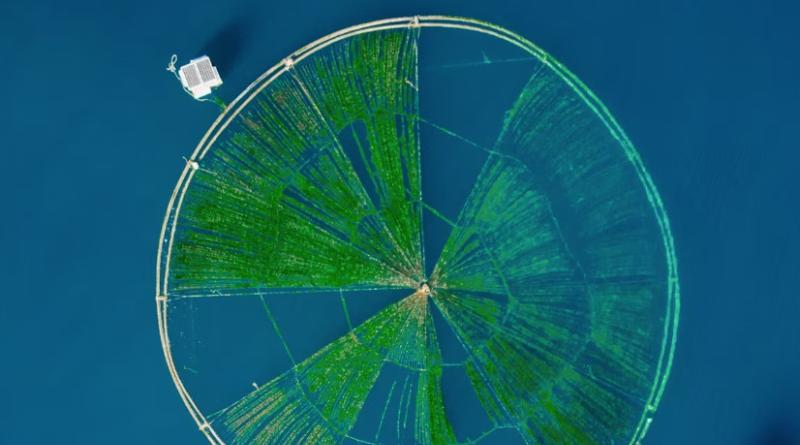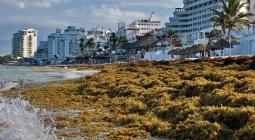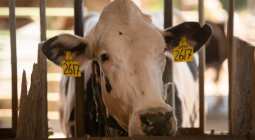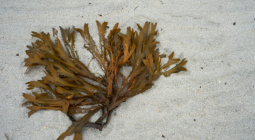‘Like a 40-metre pizza’: the seaweed farms that could feed us all – at a cost

Mammoth efforts to grow seaweed are springing up in the Philippines and beyond, and they’re in line for Elon Musk’s ‘largest incentive prize in history’. Meddling with the ocean to grow them, however, has some scientists troubled
Awhite metal platform on the surface of the Pacific Ocean faces another, smaller one some distance away. Sam Donohue stands on the big platform, Gorio Pepito on the small one. They press buttons, and a high-pitched whirring sets in.
Pepito and Donohue release the buttons. The whirring stops. They communicate by walkie-talkie. Everything’s OK. A crab walks across the big platform: that’s their pet, Donohue says. They press the buttons again.
At first nothing happens, but then it appears on the surface of the water, cresting like the back of a whale: a large metal ring, from which countless lines are stretched out in a star shape.
It’s seaweed, glowing in the light of the rising sun. Four dolphins leap from the water as if they had been ordered there for this moment.
This is Brian von Herzen’s plan for “saving the Earth”, according to his website. The founder and director of the Climate Foundation, Von Herzen wants to use highly engineered platforms to “reforest” the oceans with seaweed, thereby solving everything at once: feeding humanity, rehabilitating ecosystems and ending the climate crisis.
Last year, the Climate Foundation won the $1m Milestone award of the Xprize, sponsored by Elon Musk’s foundation, alongside 14 other teams. The teams are now competing to see who can most effectively extract carbon dioxide (CO2) from the atmosphere: the grand prize is $100m, which Musk calls “the largest incentive prize in history”.
The elephant in the blue carbon room
The prototype ring is located about 20 miles north of Cebu City in the Philippines. “Imagine a pizza with a dozen slices and a diameter of 40 metres,” said Von Herzen. The 64-year-old had described the ring in advance, before advising on snorkelling gear for the visit. “For me, it is like being in space and working on a space station,” he says. “When you look down, there is 1,000ft [300 metres] of blue water below you.”
The hi-tech ring has the patina of an old shipwreck: the sea has claimed it as its own. On its edges grow countless goose barnacles, their lobes pulsating like fans.
At 120 metres, it was in cooler 24C (75F) water (compared with about 30C on the surface) and immersed in nutrients, both of which it needs to grow. But Pepito and Donohue must raise the ring again every morning because the seaweed also needs light. It uses light to photosynthesise CO2 into sugar and oxygen, which is why the Climate Foundation is making all this effort – to help the seaweed store CO2.
The Intergovernmental Panel on Climate Change (IPCC) is clear that to stop global heating we must sequester CO2 in some way. We can plant trees to store it; scatter crushed rocks to absorb it; remove it from industrial emissions and bury it underground – or plant masses of seaweed. Each involves risks and questions about how long it can store CO2.
Von Herzen has not visited the Philippines rig since the pandemic. Instead, the American tries to explain it all from Australia, where he now lives, via video call.
“Every major ocean state has an exclusive economic zone that stretches at least 200 nautical miles from the coastline,” he says, against a background image of fish swimming through seaweed. “It is mostly empty sea and often much deeper than 300ft [90 metres]. All waters deeper than 300ft are accessible to marine permaculture.”
Algae have been called “the elephant in the blue carbon room” because they grow so fast: giant kelp can grow 50cm a day. The Climate Foundation’s seaweed grows up to three times faster than seaweed growing on the surface, Von Herzen claims.
“We could change humanity’s relationship with the ocean, from extraction to regeneration,” he says.
There are just two problems: seaweed, like coral, cannot withstand high water temperatures. And the whole thing has to pay off.
Heat is followed by ice
Filipinos have long farmed seaweed themselves, off the coasts of the country’s more than 7,600 islands. They use the simplest of means: they stretch plastic ribbons and tie seedlings (such as red gracilaria, green caulerpa, or brown gulf seaweed, also known as sargassum) to them. Empty plastic bottles are used for buoyancy.
More than a million people nationwide grow seaweed in this way. A one-hectare farm might earn about €140 (£120) every 45-day cycle. Some of it ends up in colourful baskets at fish markets, illuminated by LED lights and kept fresh by whirring fans. But much more money can be made with a prized export: carrageenan, a food additive extracted from red seaweed. Most of us consume it daily as a thickener and stabiliser – better known as E407 – in toothpaste, sweets, spreads or cream.
But the sea is now getting hotter than the seaweed can bear, causing it either to stop growing or to develop “ice-ice” disease, in which it bleaches like corals. Since 2011, seaweed production in the Philippines has fallen by about 20%. The higher temperatures also bring the natural upwelling of water – which normally mixes the colder, nutrient-rich deep water with the surface water – to a halt.
There are then two options: bring the seaweed to the deep water, or bring the deep water to the seaweed.
The latter method is highly controversial: it is called “artificial upwelling” and is a form of geoengineering. Von Herzen initially claims that, after experimenting with both methods, they are only proceeding with the former – what he calls “deep cycling”.
Their DIY methods are inventive. The energy from the solar panels is stored in 56 motorbike batteries; the buoys at the edges of the ring are discarded car-coolant tanks filled with gas; the mill which they use to grind the harvested seaweed is designed for maize (it began to rust because of the seawater and they are rebuilding the funnel from stainless steel).
Something is always going wrong, however: the team were recently surprised by a thunderstorm and, lacking a lightning rod, jumped off the platform into the water.
“Everything we work with is recycled, old or repurposed,” says Donohue, 37, the Australian head of engineering. Before meeting Von Herzen by chance in the Philippines, he worked in gold and silver mines around the world.
“But since I met Brian, I had the opportunity to do something good for the Earth,” he says. Eight dogs and five puppies are constantly jumping between the workers’ legs, lying in tool boxes and on fishing nets.
Meanwhile, on the neighbouring island of Bohol, the Climate Foundation uses its seaweed to produce fertiliser which it sells to local rice and fish farmers.
Crestito Garcia, an aquaculture farmer, says he mixes the seaweed into the feed for his fish and shrimps, and has since had better yields; Gliceria Limbaga says she has been able to stop using pesticides on her rice farm because the seaweed fertiliser keeps insects away.
Previously, she used a synthetic nitrogen fertiliser, which not only harms and acidifies the soil but, according to researchers at Cambridge University, is responsible for 5% of global greenhouse gas emissions.
“We don’t produce enough rice here in the Philippines,” says Pepe Tubal, part of the foundation. “If all the rice farmers use our product and increase their yields, I think we won’t need to import rice any more.”
He also mentions, almost in passing, that the foundation is planning several artificial upwelling projects in the region.
When pressed, Donohue and Von Herzen admit it – saying they plan to pump water to the surface through long pipes. But Von Herzen argues the term is wrong. “There is nothing artificial about restoring a natural process regionally,” he says. “We are restoring a natural process.”
However, others – including the Heinrich Böll Foundation, a German thinktank – say it is incorrect and dangerous to equate complex natural upwelling phenomena with artificial ones.
“The ocean is highly stratified, and that’s a good thing because it stores an incredible amount of CO2 in the depths,” says Andreas Oschlies, head of the biogeochemical modelling research unit at GEOMAR Helmholtz Centre for Ocean Research Kiel.
“We don’t actually want to bring this CO2 up. But when we bring artificial upwelling into the climate models, it shows that a lot of CO2 is pumped up with the nutrients.”
This then gets back into the atmosphere at the surface and could cancel out the gain in newly stored CO2. “And all the nutrients that these seaweeds take up are missing somewhere else,” Oschlies says.
“So you have a seaweed farmer somewhere who earns great money, but next door or maybe half a continent away, the fishermen suddenly catch less because less seaweed grows there because of fewer nutrients and therefore there are fewer fish.”
And the list of problems with upwelling is even longer: the deep water actually cools the atmosphere, but at the same time displaces warm surface water downwards, which can harm plants and animals below.
It can encourage the blooming of undesirable toxic algae, cause oxygen depletion in the water, and alter ocean currents (which in turn can affect weather patterns).
Even a positive effect can have deadly consequences: “Some of the marine animals that love to live in seaweed forests form calcium carbonate shells, a process that emits CO2. This can cancel out 10-30% of the seaweed’s CO2 uptake,” says Oschlies. As a member of an international expert group advising the UN, he concludes: “This method has … only a very limited potential for carbon sequestration and the risk of considerable side-effects.”
Von Herzen knows these risks. “Whether we like it or not, we have already perturbed planet Earth,” he says. “Every time you fly in a fossil fuel-powered plane or drive a car, it’s an act of geoengineering. We know the consequences of releasing more carbon into the atmosphere, and yet we keep choosing to do it.”
He claims we take a greater risk in knowingly continuing to destroy the planet than in trying to save it: “In a worst-case scenario, if there was a problem with the upwelling, we can turn off the pumps and everything goes back to the way it was before.”
Unfortunately, critics say it is not that easy. Simulations by GEOMAR, an ocean research centre in Kiel, Germany, showed that the pumps, once started, should not be stopped – because doing so would actually lead to even more CO2 and hotter temperatures than if the pumps had never been turned on. Oschlies compares it to Goethe’s Sorcerer’s Apprentice, who cannot get rid of the ghosts he summons.
Saving the world must pay off
Eventually, the Climate Foundation team want to work with seaweed farmers whose own crop is failing due to rising sea temperatures. The plan is for farmers to lease the systems from the Climate Foundation, which in turn will buy their entire harvest, and use it to make biofertiliser and carrageenan.
But like a forest on land, seaweed only stores CO2 as long as it is not harvested and processed. To extract as much CO2 as possible out of the atmosphere, the Climate Foundation would have to let it sink to the seabed, where it would be eaten, decomposed or buried in sediment. The deeper the seaweed sinks, the longer the CO2 is stored. At a depth of about 900 metres, it takes about 1,000 years, at about 300 metres only about 100 years. The deep-cycling platform off the coast of Cebu hangs in just 220 metres of water.
But if you let all the seaweed sink to the bottom of the ocean, you cannot earn money from it. The Climate Foundation has looked at trying to make the finances work by selling carbon-offsetting certificates, but concluded that it was not profitable. So, only the seaweed that falls off naturally (“like leaves from trees”, as the Climate Foundation describes it) will store any CO2 over the long-term. Von Herzen estimates that is about 20-40% of the crop.
The team in Cebu wear new T-shirts with an image of seaweed growing upwards; on the back is written: “Food security, ecosystems, carbon removal”, in that order. Should climate really come last? “Let’s focus on making sure we can feed humanity through the climate-disrupted decades to come,” Von Herzen says.
“We can measure the seaweed that sinks down from the platform. We can measure the carbon removals and the emissions avoided through agricultural intervention and document those benefits. But we need to provide food security and ecosystem regeneration, so that we can regenerate healthy ecosystems on land and in the ocean for future generations.”
Asked how local people react to the Climate Foundation, one of the staff makes a telling remark: “They are under the impression that we are in the seaweed business.”
Photograph: Fabian Weiss






